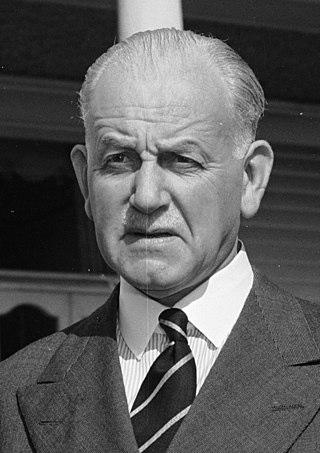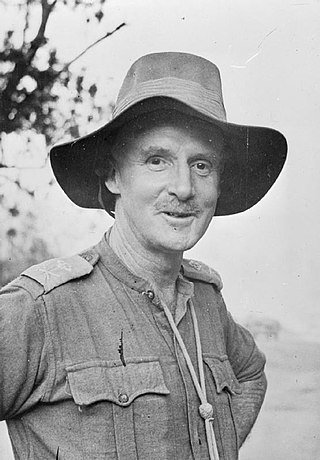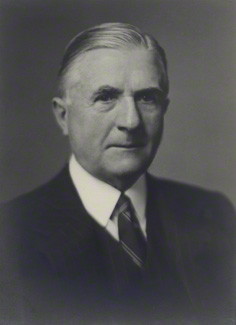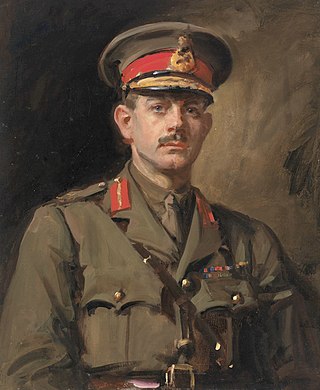Related Research Articles

Field Marshal Sir Claude John Eyre Auchinleck,, was a British Army commander during the Second World War. He was a career soldier who spent much of his military career in India, where he rose to become Commander-in-Chief of the Indian Army by early 1941. In July 1941 he was appointed Commander-in-Chief of the Middle East Theatre, but after initial successes, the war in North Africa turned against the British, and he was relieved of the post in 1942 during the North African campaign.

Marshal of the Royal Air Force William Sholto Douglas, 1st Baron Douglas of Kirtleside, was a senior commander in the Royal Air Force. After serving as a pilot, then a flight commander and finally as a squadron commander during the First World War, he served as a flying instructor during the inter-war years before becoming Director of Staff Duties and then Assistant Chief of the Air Staff at the Air Ministry.

Field Marshal Archibald Percival Wavell, 1st Earl Wavell, was a senior officer of the British Army. He served in the Second Boer War, the Bazar Valley Campaign and the First World War, during which he was wounded in the Second Battle of Ypres. In the Second World War, he served initially as Commander-in-Chief Middle East, in which role he led British forces to victory over the Italians in western Egypt and eastern Libya during Operation Compass in December 1940, only to be defeated by the German Army in the Western Desert in April 1941. He served as Commander-in-Chief, India, from July 1941 until June 1943 and then served as Viceroy of India until his retirement in February 1947.

Sir John Greer Dill, was a senior British Army officer with service in both the First World War and the Second World War. From May 1940 to December 1941 he was the Chief of the Imperial General Staff (CIGS), the professional head of the British Army, and subsequently served in Washington, D.C., as Chief of the British Joint Staff Mission and then Senior British Representative on the Combined Chiefs of Staff (CCS).

Lieutenant-General Charles Willoughby Moke Norrie, 1st Baron Norrie,, was a senior officer of the British Army who fought in both World Wars, following which he served terms as Governor of South Australia and the eighth Governor-General of New Zealand.

Field Marshal Sir Thomas Albert Blamey, was an Australian general of the First and Second World Wars, and the only Australian to attain the rank of field marshal.

General Sir Frank Walter Messervy, was a British Indian Army officer in the First and Second World Wars. Following its independence, he was the first Commander-in-Chief of the Pakistan Army. Previously, he had served as General Officer Commanding-in-Chief Northern Command, India in 1946 and 1947.

Clyde LaVerne Herring, an American Democratic politician who served as the 26th governor of Iowa, and then one of its U.S. senators, during the last part of the Great Depression and the first part of World War II.

Thomas Sivewright Catto, 1st Baron Catto CBE PC was a Scottish businessman and later Governor of the Bank of England.

Group Captain Peter Wooldridge Townsend, was a British Royal Air Force officer, flying ace, courtier and author. He was equerry to King George VI from 1944 to 1952 and held the same position for Queen Elizabeth II from 1952 to 1953. Townsend notably had a romance with Princess Margaret, Elizabeth's younger sister.

Marshal of the Royal Air Force Sir John Grandy, was a senior officer in the Royal Air Force. He was the only officer who fought and commanded a squadron during the Battle of Britain to reach the post of Chief of the Air Staff. In the latter role he implemented the final stages of the RAF's withdrawal from the Persian Gulf and the Far East, oversaw the ordering and subsequent cancellation of the F-111 strike aircraft and handed over Britain's nuclear deterrent role to the Royal Navy.

Lieutenant-General Sir Archibald Edward Nye, was a senior British Army officer who served in both world wars. In the latter he served as Vice-Chief of the Imperial General Staff (VCIGS).

Wing Commander Robert Roland Stanford Tuck, was a British fighter pilot, flying ace and test pilot. Tuck joined the Royal Air Force (RAF) in 1935 and first engaged in combat during the Battle of France, over Dunkirk, claiming his first victories. In September 1940 he was promoted to squadron leader and commanded a Hawker Hurricane squadron. In 1941–1942, Tuck participated in fighter sweeps over northern France. On 28 January 1942, he was hit by anti-aircraft fire, was forced to land in France, and was taken prisoner. At the time of his capture, Tuck had claimed 29 enemy aircraft destroyed, two shared destroyed, six probably destroyed, six damaged and one shared damaged.

Lieutenant General Sir Iven Giffard Mackay, was a senior Australian Army officer who served in both world wars.

Lieutenant General Sir Edmund Francis Herring, was a senior Australian Army officer during the Second World War, Lieutenant Governor of Victoria, and Chief Justice of the Supreme Court of Victoria. A Rhodes scholar, Herring was at New College, Oxford, when the First World War broke out and served with the Royal Field Artillery on the Macedonian front, for which he was awarded the Military Cross and Distinguished Service Order. After the war he carved out a successful career as a barrister and King's Counsel. He also joined the Australian Army, rising to the rank of colonel by 1939.

General Sir Charles Frederic Keightley, was a senior British Army officer who served during and following the Second World War. After serving with distinction during the Second World War – becoming, in 1944, the youngest corps commander in the British Army – he had a distinguished postwar career and was the Governor of Gibraltar from 1958 to 1962.

Boddam is a coastal village in Aberdeenshire, Scotland. It is 29 miles (47 km) north of Aberdeen and 3 miles (4.8 km) south of Peterhead. The settlement of Stirling Village lies immediately to the west. Sea cliffs rise to 200 feet (61 m), south of the village: a coastal path leads along these to the Bullers of Buchan.
The Formartine and Buchan Railway was a railway company operating in the north-east of Scotland. It was built to link the important fishing ports of Fraserburgh and Peterhead with Aberdeen. It had a junction with the main line of the Great North of Scotland Railway (GNoS) at Dyce. Due to shortage of finance, the line was opened in stages as money became available. The section from Dyce to Mintlaw opened in 1861, and from there to Peterhead in 1862. The Fraserburgh line opened in 1865. The Company was never profitable, and it was heavily supported financially by the GNoSR; it was formally absorbed by that company in 1866.

Frederick Martin CBE was a Scottish Liberal, later Labour politician and journalist.
Robert Samuel Herring was a British officer who served in the Army and the Royal Air Force in both World Wars. In World War I he became a flying ace, and spent most of World War II as a prisoner of the Japanese.
References
- ↑ Webster J. Another Grain of Truth Glasgow,1989 p.66.
- ↑ [ dead link ]
- ↑ "Settlement of Herring Deal at Last" . Aberdeen Press and Journal . No. 24168. 17 June 1932. p. 7. Retrieved 2 May 2020– via British Newspaper Archive.
- ↑ "Annual Statistics". scottishherringhistory.uk.
- ↑ "Page 270 | Issue 15814, 23 May 1941 | Edinburgh Gazette | The Gazette".